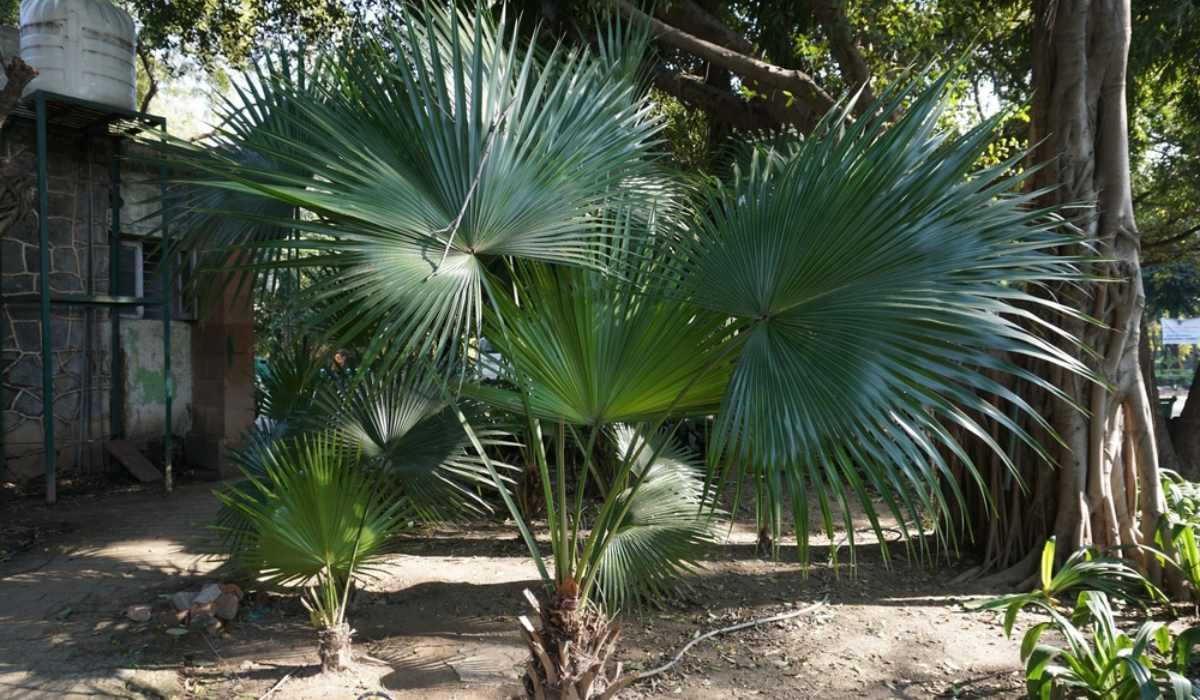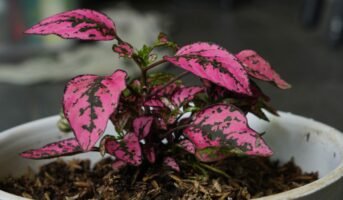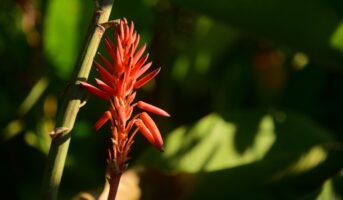The Chinese fan palm, scientifically known as Livistona Chinensis, is a plant with fronds that spread out and can reach a width of 2 feet (60 cm). This palm exhibits grace when it is fully grown. It is a lovely adornment for the home with broad, fan-shaped foliage held on tall branches.
This palm can tolerate typical indoor temperatures and is a pleasant plant. You may enjoy your indoor palm for many years if you take good care of it.
See also: 21 best flowers for your garden
Livistona Chinensis: Quick facts
| Common Name | Chinese fan palm |
| Family | Arecaceae |
| Native | Japan, Taiwan |
| Sunlight | Full Sun |
| Plant growth form | Solitary Palm |
| Bloom Time | Spring |
| Flower colour | Snowy white |
| Soil pH | Acidic/ neutral |

Source: Pinterest
Livistona Chinensis: Physical features
Stem
Grey or brown, single, erect, up to 12 metres tall, and 25 cm in diameter. Old leaves stay on the stem, and as they fall off, they leave closely spaced rings of leaf scars. The rings eventually disappear, leaving a stem that is mostly smooth (corky at the base).
Leaves
Costapalmate, induplicate, dull olive green, up to 2 m broad, and divided into stiff segments with drooping, bifid tips for about two-thirds of their length. The base of the petiole is equipped with strong marginal teeth (sometimes lacking these teeth).
Flowers and fruit
The inflorescences have five orders and are between one and five metres long. Both male and female flower structures are light yellow. When fully grown, the fruit is ovoid, 2 cm across, and green to greyish blue in colour.
Seeds
Livistona Chinensis plants are grown from seeds. The seeds are known to have medicinal benefits.
Livistona Chinensis common names
Livistona Chinensis are known by different names such as Chinese Fan Palm, Table Palm, and Fountain Palm. It is a subtropical palm tree, which is found widely across east Asia. Livistona Chinensis belongs to the Livistona genus of palms from the Arecaceae family.
Livistona Chinensis: How to grow?
Although the process is slow, it is possible to grow Chinese fan palms from seeds collected after the inflorescence fades. (These spring flowers are not showy and are sometimes overlooked behind the massive leaves.)
Fruit seeds can be planted in a rich mixture of potting mix and perlite or sand, just enough to cover the seeds. If the seeds are kept moist and warm, they should germinate and develop into seedlings that can be transplanted into individual pots (see above). But be patient, because growing a mature plant from seed takes years.
Livistona Chinensis: Caring instructions
Light
Chinese fan palms thrive in full sun to partial shade, which means they require between six and eight hours of bright sun on most days. Young palms prefer shade, particularly from the hot summer sun. These palms thrive indoors when placed near a bright window with indirect light.
Soil
If there is good drainage, these palms can tolerate a wide range of soil types, including sandy and clay. They thrive in rich loamy soil with a pH that ranges from slightly acidic to neutral. For container-grown plants, use a quality potting mix designed specifically for palms.
Watering
After properly watering, let the soil gradually dry between applications. In the winter, when growth has stalled, use less water. Because tap water may contain fluoride, chlorine, and other chemicals that might harm hands, use filtered or distilled water instead. Avoid getting the base of the palm wet when watering to avoid rot. To avoid damp soil, choose a container with drainage holes and quick-draining potting soil.
How often should you water livistona?
The plant needs adequate watering to promote growth. It is essential to keep the topsoil slightly moist. However, watering must be done when the soil is 50% to 75% dry. Thus, you can water livistona plants once in 5 days. Potted plants may also need two to three watering sessions in a week.
Pruning
To maintain its shape, the Chinese fan palm doesn’t require pruning. Never remove the top of it. The terminal tip of palms, unlike many other plants, is where all new growth originates, hence removing it kills the stem. Older fronds should be removed if they have turned brown. Using sharp pruners, remove any old fronds close to the trunk. Avoid pulling them off, as this could harm the tree.

Source: Pinterest
Livistona chinensis: Uses
Although the Chinese fan palm has long been used as a container palm, its neat leaf habit and interesting form make it ideal for additional landscape use, such as staggered groupings or as a freestanding specimen or street tree. When planted about ten feet apart along a walk or street, they form a closed canopy. They thrive in small soil spaces. The palm cleans itself of old leaves and requires little to no pruning.
Moreover, the Chinese fan palm fruits have been used in traditional medicine as an anticancer agent. The seeds and fruits have specific compounds, called phenolic compounds, which have antibacterial properties.
See also: What is mint and what are its numerous benefits?
Livistona chinensis: Is it an indoor plant?
Chinese fan palms are non-toxic and make an excellent indoor plant for a sunny room. This attractive palm has a single, upright trunk and large leaves that can grow to be 6 feet (2 metres) long.
How fast does a Chinese fan palm grow?
Palm trees like King palm are known to grow fast. However, the Chinese fan palm tree may have a slow growth for the initial 10 years. However, it grows around 6 to 8 inches every year.
What is the approximate height of Livistona Chinensis?
Livistona Chinensis or Chinese fan palm trees grow to reach a height of around 25 to 30 feet, and have a large, robust crown. In their natural subtropical habitat, the trees can attain a maximum height of over 40 feet.
Livistona Chinensis: Common problems
Chinese fan palm usually do not face serious problems with pests or diseases. They may be prone to attacks by scale insects and spider mites, which may damage the leaves or potentially kill the plants. You can apply insecticidal soap or neem oil spray to treat pest infestations.
Moreover, the plants may have discoloured leaves, which can a result of lack of nutrients especially potassium. One way to deal with this is to use fertiliser formulated for palms.
How long do Chinese fan palms live?
Garden specimens of Chinese fan palms usually have 40-year lifespan. However, the indoor plants are less likely to have such longevity.
FAQs
What are the fertiliser requirements for Livistona chinensis?
Chinese fan palms do not enjoy a consistent diet of liquid plant food, unlike most indoor plants. They grow slowly and don't require a lot of fertiliser, especially when grown inside. Use a slow-release fertiliser to feed your palm trees.
What are the sunlight requirements?
Place the Chinese fan palm in a well-lit area away from the sun. Turn it a quarter turn once a week or so to ensure that all sides receive light for optimum growth.
Housing News Desk is the news desk of leading online real estate portal, Housing.com. Housing News Desk focuses on a variety of topics such as real estate laws, taxes, current news, property trends, home loans, rentals, décor, green homes, home improvement, etc. The main objective of the news desk, is to cover the real estate sector from the perspective of providing information that is useful to the end-user.
Facebook: https://www.facebook.com/housing.com/
Twitter: https://twitter.com/Housing
Email: [email protected]











